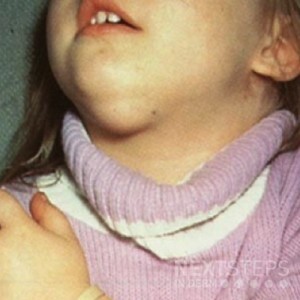
The correct answer is E. Bartonella henselae.
This is submental lymphadenopathy secondary to cat scratch disease due to bartonella henselae. It is one of the most common causes of chronic lymphadenopathy in children. Catscratch disease is a bacterial infection that affects the lymph nodes. It is also known as catscratch fever or subacute regional lymphadenitis. Patients with catscratch disease usually have suffered a scratch or bite from a cat or kitten that is infected with the bacteria Bartonella henselae, a common infection in young cats. It is also known as Rochalimaea henselae. The bacteria is passed from cat to cat via fleas.
B. quintana causes bacillary angiomatosis and trench fever. B. bacilliformis causes Oroya fever/verruga peruana. B. burgdorferi causes Lyme disease, and B. recurrentis causes relapsing fever.
References:
Chang CC, Lee CJ, Ou LS, Wang CJ, Huang YC. Disseminated cat-scratch disease: case report and review of the literature. Paediatr Int Child Health. 2016;36(3):232-234. doi:10.1179/2046905515Y.0000000005. Florin TA, Zaoutis TE, Zaoutis LB. Beyond cat scratch disease: widening spectrum of Bartonella henselae infection. Pediatrics. 2008;121(5):e1413-e1425. doi:10.1542/peds.2007-1897
